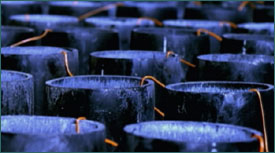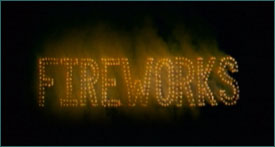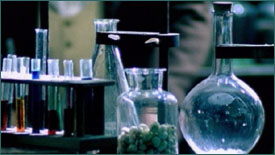 |
 |
|
Pyrotechnically Speaking
Everyone loves fireworks, but it's safe to say that few love them as much as
does Dr. John Conkling. An adjunct professor of chemistry at Washington College
in Chestertown, Maryland, and a past executive director of the American
Pyrotechnics Association, Conkling has made fireworks his life. With eight
patents in energetics under his belt, he has mixed and matched chemicals in
both military and civilian applications for over three decades. As he makes
clear in this interview, even after all these years his enthusiasm remains as
bursting as a 12-inch peony shell.
NOVA: You've been in this field for three decades. How have fireworks changed
over that time?
Conkling: The colors have definitely gotten brighter; new chemical mixtures
have brightened shows considerably. Also, we shoot shows much faster today than
we did 30 years ago. A fireworks display back then may have lasted an hour;
today, if it lasts 20 minutes it's a long fireworks show. The public has come
to want all its entertainment fast and furious, and the industry has had to
keep up with it.
 Unlike in the old days,
today fireworks are set off electronically in rapid-fire, computer-controlled,
highly choreographed productions.
Unlike in the old days,
today fireworks are set off electronically in rapid-fire, computer-controlled,
highly choreographed productions.
|
|
NOVA: So what's the next big thing in fireworks?
Conkling: Well, even better choreography—the ability to time fireworks with
music so you can match notes of music with fireworks effects. Electronic firing
has let us do this, as has better quality control in the fusing of the
fireworks themselves.
Again, this goes along with the public's demand for really precise, spectacular
entertainment. The old way of maybe playing a musical selection and shooting
some fireworks doesn't cut it anymore. When the "Star-Spangled Banner" is
playing and you hear "rockets red glare," at that precise moment the public
likes to see the sky explode in red. You do it five seconds before or five
seconds after and they wonder "What was that for?" So you really have to match
well, and we're getting really good at that.
|  Would-be wordsmiths:
Pyrotechnicians count among current pressing challenges the ability to spell
words in the sky.
Would-be wordsmiths:
Pyrotechnicians count among current pressing challenges the ability to spell
words in the sky.
|
NOVA: What about spelling out letters in the sky?
Conkling: The pattern shell is another recent area of innovation—the ability
to have aerial fireworks burst and form a perfect heart or a five-pointed star
or a smiling happy face. The next logical progression of that will be the
ability to create a letter with aerial shell bursts—the pellets come out in
the shape of a letter. Obviously, if you can make one letter, there's the
potential to string a few letters together and spell out "NOVA" or some other
word. We're not there yet. We're still a ways from it, but there's interest in
being able to do that.
NOVA: How about fireworks used indoors, so-called "cold" fireworks?
Conkling: In recent years there has indeed been an increased use of
entertainment pyrotechnics, that is, the indoor application of pyrotechnics.
They can't produce the smoke that a lot of outdoor fireworks produce, and they
can't be as hot. But pyrotechnic mixtures that are considerably lower in
temperature are of great interest, and there's been some real progress. Some
people call them "cold" fireworks, but they're still pretty warm.
 Fireworks makers are moving behind the standard color palette and into the
realm of the specialty hue.
Fireworks makers are moving behind the standard color palette and into the
realm of the specialty hue.
|
|
NOVA: Does the chemistry become increasingly complex as you come up with new
colors?
Conkling: Color mixing is advancing. We can usually make a pretty deep red, a
nice green, a reasonable blue. Now, if you start to combine the red and the
blue, you get violet, lilac, purple. There's interest in being able to make
lime-green, a beautiful orange, and so on. That takes a real careful mixing of
color technology. We keep getting better and better. As research continues,
we're still making advancements.
NOVA: What new colors should we expect down the pike? Chartreuse? Aquamarine?
Hot pink?
Conkling: I think the whole palette! I see no reason why there should be much
limitation on the colors we see. It's just a question of R&D effort as well
as demand. It's usually driven from the entertainment side. A theme park may
want a very specific effect for a show they're doing, and they'll say "Give me
lime-green." Once a company starts to develop a lime-green, they start
thinking, well, we have this new color, let's find some other customers who
would like to have it as well.
NOVA: I've heard that some of the greatest innovations in fireworks are made by
amateurs. Is that true?
Conkling: Absolutely. There is a several-thousand-member group called the
Pyrotechnic Guild. They are private citizens who love fireworks; they love
setting them off. A number of them have small laboratories in their basements
or sheds, where they do a little experimentation. They have the interest, time,
and patience to do test after test after test, trying to create the perfect
color, the perfect spark. So they are not a group to be dismissed lightly. They
have as members some highly intelligent people with a strong interest in
enhancing the science and the art of fireworks.
|  All in
a day's work: Pyro Boy, aka the Seattle-based performance artist Wally Glenn,
truly sparkles on stage.
All in
a day's work: Pyro Boy, aka the Seattle-based performance artist Wally Glenn,
truly sparkles on stage.
|
NOVA: Speaking of amateurs, what do you think of Pyro Boy? He's the guy who
loads himself up with fireworks and dances on stage as the fireworks go
off.
Conkling: Well, he is flirting on the edge with that act. He's totally relying
on the manufacturer of the devices to have an extremely high degree of quality
control. I certainly hope he wears protective armor, because if one of those
devices were to malfunction, he certainly has the potential to injure
himself.
NOVA: Is your work dangerous? Ever had any serious injuries from working with
these chemicals?
Conkling: No, I tend to be very careful. I work with very limited quantities of
material, certainly until I am well aware of all a new material's properties—its sensitivity, its output. People have to be extremely cautious if they're
working or even dabbling in this field, as there is the potential for injury.
You should know your science well before you ever attempt to do any of this at
home.
Continue: Greatest concerns regarding firework safety
Photo credits
Name That Shell |
Anatomy of a Firework |
Pyrotechnically Speaking |
On Fire
Resources |
Transcript |
Teacher's Guide |
Site Map |
Fireworks! Home
Search |
Site Map |
Previously Featured |
Schedule |
Feedback |
Teachers |
Shop
Join Us/E-Mail |
About NOVA |
Editor's Picks |
Watch NOVAs online |
To print
PBS Online |
NOVA Online |
WGBH
© | Updated January 2002
|
|
|
|